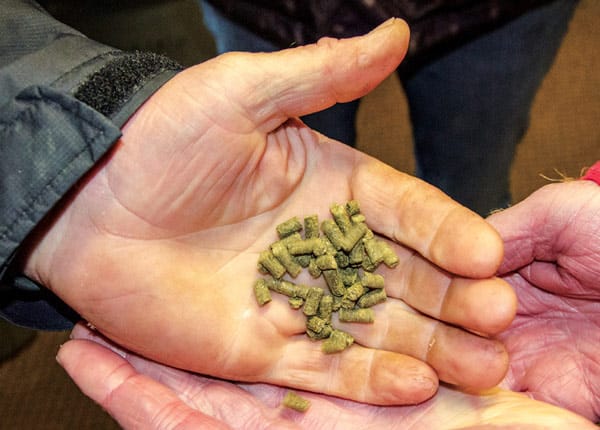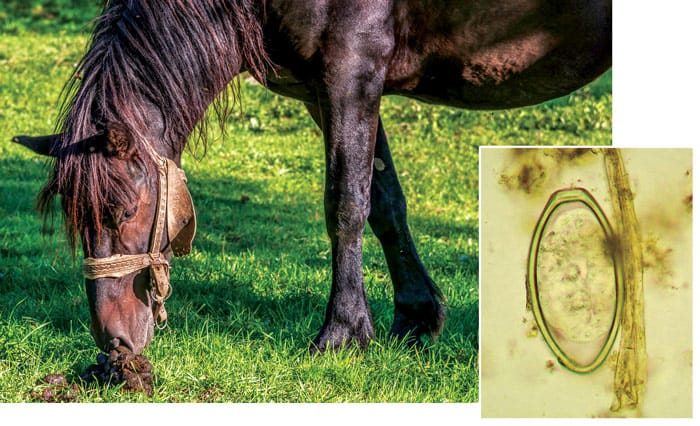Pictured Above: Paying attention to the quality and consistency of their clients’ horses’ manure, coupled with a regular trimming and shoeing schedule, led the Mast brothers to offer a de-worming service. They collect samples for a local veterinarian to conduct fecal egg counts. Their efforts have paid off, with more than 60% of their clients signing on.
As a farrier, providing equine hoof-care services to your clients is a valuable commodity. Yet, there are a number of ways to increase your value and ensure long-lasting business relationships with clients.
According to the American Farriers Journal 2019 Farrier Business Practices Survey that will be officially released in a special report with the December 2018 issue, the typical full-time farrier has an average of 20 years of experience. After more than a quarter century of experience, the typical farrier is going to accumulate a fair amount of knowledge about horses that clients can lean on. Why not tap into it and share it with your clients? It not only can add value to your practice, but it can supplement your bottom line as well.
Identify Influencing Factors
How do you determine which knowledge or service will be helpful to your clients? Each practice and client is different. You might have a greater interest or stronger aptitude in a specific area. Or there might be a particular problem in your area where you can use your specialization to set yourself apart.
Farrier Takeaways
- Performing an analysis of the strengths, weaknesses, opportunities and threats to your hoof-care practice will help you identify the internal and external factors that can influence your business.
- Identifying a gap among your clients and fulfilling a need during your normal shoeing cycle — such as a de-worming service — can enhance your value.
- Selling products to your clients not only can supplement your income, but it also can help encourage them to follow through with daily duties, such as treating white line disease, and result in better and easier feet to work on.
A popular method for determining the direction you should take is by conducting a SWOT — or Strengths, Weaknesses, Opportunities and Threats — analysis (Figure 1). Developed in the 1960s, a SWOT analysis examines these areas to identify the internal and external elements that can influence your business.1 Strengths and weaknesses represent the internal factors that can affect your business, while opportunities and threats are external influences.
To be effective, this exercise demands that you are as honest with yourself as possible. Identify five or six reasonable items that accurately reflect the strengths, weaknesses, opportunities and threats that your hoof-care practice faces.
Strengths. Where does your hoof-care practice excel and separate itself from your competition? Perhaps your feet are strong and have few problems. Perhaps you enjoy a loyal clientele or you have very little debt. Your training through continuing education is superior to other farriers in your area. How can you capitalize on the strengths that you identified to attract new clients or solidify your practice?
Weaknesses. Where does your hoof-practice lag behind your competition? Do you have a large amount of money tied up in unused inventory? Is your truck unreliable? Are you constantly late to appointments? It’s important to identify where your practice needs to improve and set a plan in motion to address the deficiencies to remain competitive.
Opportunities. Is there a service gap in your area? Do your clients neglect to follow through on something simply because they don’t have the time to pick something up at the supply shop? Filling a client’s void can be a beneficial way of improving your business.
Threats. What external factors can potentially harm your business? If you lost one barn, how would it affect your bottom line? Rising costs, increased competition and another farrier’s willingness to do the job for less money are all examples of threats.

Identifying An Opportunity
How many times a day do you grab a broom or shovel to clean up manure while trimming and shoeing for your clients? When doing so, the Mast brothers simply took note of the quality and consistency of a horse’s manure.
“We might see something that doesn’t look quite right,” explains Laverne Mast, who practices farriery with his brother Larry in Millersburg, Ind. “We’ll check with the owner and ask, ‘Did you just de-worm it? If you did, good. If you didn’t, you have a problem.’”
The Masts found that many clients were inconsistent with de-worming their horses.
“What we were finding was when you asked them the last time they de-wormed, they would reply that they did it just recently,” Larry Mast says. “Well, it was probably last fall or the fall before that. They just didn’t get around to it.”
They recognized an opportunity to provide a service.
“We offer a de-worming program three or four times a year,” says Larry Mast, noting that they work with a local veterinarian. “When they get on the program, we’ll rotate the de-wormers and keep track and do it for them. The main reason why we do the de-worming is that we’re on a schedule to trim and shoe the feet. So, this is an easy option for them. It takes care of our parasite questions.”
The service has proven to be popular among the Masts’ clients, with more than 60% signing on.
“We go through 20 to 22 cases around four times a year of the same de-wormer, so we get it at a pretty decent price,” Laverne Mast says, noting that they de-worm approximately 260 of the 425 horses in their appointment book. “That’s the kind of relationship we try to keep. We want to be ahead of the game. The horse is the winner.”
Selling Products
Approximately 31% of full-time farriers sell products to clients, while another 21% of part-time farriers do the same. While most make a little money to augment the income from trimming and shoeing, that’s not usually what compelled them to keep products on their trucks.
“The main reason I carry product with me is that a lot of times it’s difficult to get clients to follow through on something,” says Dallas Risser, an Oakland, Md., farrier. “If we’re discussing it and I have an option right there for the client, they’re probably going to do it or they’re going to do it a lot quicker.”
The wet conditions of northern Florida mean that Scott Elliott sees a lot of white line disease. He relies on his clients to help keep the fungal invasion in check by applying Hoof Pro Formula.
“They won’t go get it unless I have it on my truck,” says the Live Oak, Fla., farrier. “Then you’re just fighting the same problem you’ve had before and it doesn’t clear up.”
Although Elliott makes some money by selling Hoof Pro Formula, he finds the results pay more dividends.
“It helps a little bit, but I don’t charge much for it,” he says. “I just like the customers to use it every day. I like it because it helps get rid of white line disease. It keeps their feet together. When the horses’ feet look good, that’s the main reason you do it. And it makes me look better when the horses’ feet look good. If the client will doctor the horses’ feet with it, we’ll get that fungus out of there.”
Risser carries Life Data Labs products on his truck for much the same reason.
“There are a lot of products out there that I’ve never tried,” he says. “So I’m not going to say that one is the only one that works. When I do recommend a product, right in the same sentence I tell them there have been horses that I’ve given this to and it hasn’t fixed the problem, but it definitely won’t hurt to try it.”
Typically, Risser frames it as an open-ended trial run.
“I’ll tell them to try it for 60 days and see what we get,” he says. “If we can see a change, we’ll stick with it. If we don’t see a change, we’ll do something else. I’m open to any product that works.”
Both of the Mast brothers also sell Life Data Labs and concur with Risser about giving any product a fair shot.
“Usually you can see a difference in the hairline after 6 weeks or so,” Larry Mast says. “Overall coat condition might change a little bit, but it’s not obvious enough for me in one 6-week period. You need 60 to 90 days.”
Yet, it’s also important to understand the time of year and how it affects the horse.
“Oftentimes, a change in the time of year will make a difference,” Larry Mast says. “In November you don’t want to tell a client that 2 months from now their horse is going to be nice and slick. If you do it in March, you’re going to be right. They’ll lose the winter coat.”
If a client is unwilling to give a product a shot, Larry Mast is frank with them.
“If people are willing to use Farrier’s Formula, that’s good,” he says. “If not, but something else works for them, then I work with that. If they’re not willing to spend the extra money to help the horse, then I tell them that they have to be satisfied with a little bit less of a complete project. That’s about it.”

Selling supplements and other products from your truck can be a convenience for clients who just never get around to picking up what’s needed to keep their horses’ feet strong and healthy.
Sharing Your Knowledge
Of course, you don’t have to sell a product to provide a service. As an experienced farrier, you have accumulated knowledge through the years. Simply asking the right questions or offering advice that’s backed by factual knowledge will elevate your practice in the eyes of your clients.
Although Manalapan, N.J., farrier Thomas Picinich doesn’t sell supplements, he understands the importance of nutrition.
“If I see something in the feet, I’ll ask about the diet and if they take supplements,” he says. “I’ll tell them what I’m seeing. I’ll suggest that they talk to a vet, go online, call a supplement manufacturer and get some literature. Ask them questions. I tell them not to be afraid to call a manufacturer and tell them, here’s what you have with your horse. Ask them if they offer any type of supplement feed to help with this? If they say yes, get a sample that will last a couple of months. If they don’t offer samples, hang up and go on to the next one.”
Sometimes, it’s not what the horse is eating — it’s what it’s drinking.
“I also ask them about the water,” Picinich says. “Some horses with high iron, it does something to the feet. At one barn, you could see a film on top of the water. I’m thinking, ‘Horses drink this? That’s crazy.’”
One of his clients switched barns and the result was noticeable in the feet.
“Where she had the horse, the water was higher in iron and we were having a problem,” Picinich says. “Now, there’s no problem. It turns out that the water is a whole lot better. It’s well water that’s filtered through salt.“
Although Risser recommends a product based on his experiences, he’s cautious about speaking out of turn.
“I’m not a nutritionist,” he says. “That’s not my field. I point them to the manufacturer if they have a question. I’m not going to try to give them ingredients or tell them how it’s working.”
Whether you’re offering de-worming services, selling a product or simply sharing your knowledge, enhancing your value to your hoof-care clients beyond everyday trimming and shoeing can help you build long-lasting business relationships for years to come.
Reference
1. Learned EP, Andrews KR, Christensen CR and Guth WD. Business Policy: Text And Cases. Homewood, Ill.: Irwin, 1965.









Post a comment
Report Abusive Comment